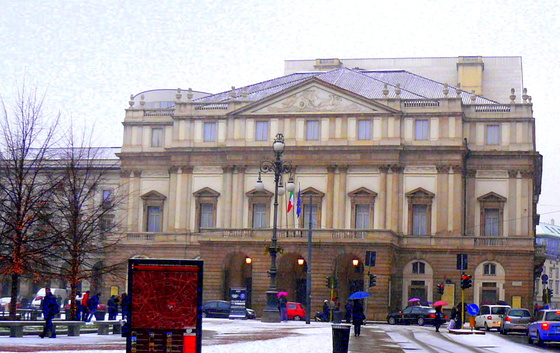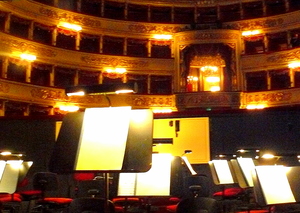
MILAN--It may not be as grand, lavish and ornate as, say, the Opéra Garnier in Paris (built in the Napoleonic style 100 years later), but the Teatro alla Scala--after two years of technical remodeling and interior refurbishing--has returned to the summit of the world's great opera houses.

Built in 1778, La Scala today seats some 2,030 opera-goers, starting with rows and rows of burgundy-colored seats on the ground floor. A video display on the seatback shows the dialog, in the language of the singers and in a choice of Italian or English. You can see (in the bootlegged panorama taken surreptitiously from the Royal Box) that a giant black rectangle for supratitles, like the ones projected in Seattle and New York, simply would not work here. You can also see stagehands assembling the set for the current production of Wagner's Die Walkürie ; dem's da flying horses in the very back of the stage (almost 18,000 square feet of space, enough for three or four complete sets; traps to a depth of 60 feet, flies to a height of 120 feet).
Then four levels of plush red boxes, 36 on each level. At the center, the boxes seat six; as they get closer to the stage (with poorer views), five seats, then four. The boxes were once owned by local families who even had private kitchens in the arrière-loge , but today the seats are sold individually, top price (240 euros, $350!!) for the front spots, less for the back. At the top of the house, two levels of "galleries," supposedly standing room, with the last 140 second-row seats going on sale nightly for 10 euros. (See Cornichon's previous entry, Postcard from Milan for details.) They're standing-room seats if you want to see anything; there's actually a chair if all you want to do is listen.
 And what do you hear? The best acoustics imaginable and the largest orchestra pit in Europe, 25 feet deep, with a pine floor that maximizes the sound of 110 musicians. (A great view of the Royal Box, too, if you're not concentrating on the conductor or your score.) Singers have to project over that abyss; it's no wonder that it's virtually impossible to sing at La Scala for one's entire career. And the standees, the reguars who hang out in the gallery, they know what's what. They hooted Roberto Alagna off the stage one night, propelling his understudy, Antonello Palombi, into the production of Aida wearing street clothes. (There's a Seattle connection, by the way. Palombi arrived at McCaw Hall a few weeks later to sing the lead in Pagliacci; Cornichon's reviews are here and here.)
And what do you hear? The best acoustics imaginable and the largest orchestra pit in Europe, 25 feet deep, with a pine floor that maximizes the sound of 110 musicians. (A great view of the Royal Box, too, if you're not concentrating on the conductor or your score.) Singers have to project over that abyss; it's no wonder that it's virtually impossible to sing at La Scala for one's entire career. And the standees, the reguars who hang out in the gallery, they know what's what. They hooted Roberto Alagna off the stage one night, propelling his understudy, Antonello Palombi, into the production of Aida wearing street clothes. (There's a Seattle connection, by the way. Palombi arrived at McCaw Hall a few weeks later to sing the lead in Pagliacci; Cornichon's reviews are here and here.)The new La Scala is so technically proficient that it is able to present over 270 performances a year, 70 percent more than before the remodeling project. That's good news to opera lovers here (and La Scala has its share of locals who attend virtually every performance). It's also good news to the administration, which needs those box office receipts. Attendance is strong, running at well over 90 percent capacity. Altogether, an enviable position for an opera house.that's been around for 200 years.
One last note: La Scala was the first public building in Europe to be illuminated by electricity. Today, the chandelier alone has nearly 400 bulbs; the monthly electric bill is close to $200,000.
No comments:
Post a Comment